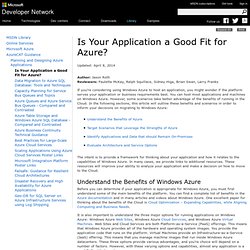

Migrating Data-Centric Applications to Windows Azure. Publishing a Windows Azure Application using the Windows Azure Tools. Updated: April 9, 2014 By using the Azure Tools for Microsoft Visual Studio, you can publish your Azure application directly from Visual Studio.

Visual Studio supports integrated publishing to either the Staging or the Production environment of a cloud service. Before you can publish an Azure application, you must have an Azure subscription. You must also set up a cloud service and storage account to be used by your application. You can set these up at the Azure Management Portal. When you are developing and testing an Azure application, you can use Web Deploy to publish changes incrementally for your web roles. Use the following procedures to publish your Azure application and to update a web role by using Web Deploy: When you publish your Azure application, you can do one of the following tasks: Create a service package: You can use this package and the service configuration file to publish your application to a deployment environment from the Management Portal.
Requirements See Also. Is Your Application a Good Fit for Windows Azure? Author: Jason RothReviewers: Paulette McKay, Ralph Squillace, Sidney Higa, Brian Swan, Larry Franks If you're considering using Windows Azure to host an application, you might wonder if the platform serves your application or business requirements best.

You can host most applications and machines on Windows Azure. However, some scenarios take better advantage of the benefits of running in the Cloud. In the following sections, this article will outline these benefits and scenarios in order to inform your decisions on migrating to Windows Azure: The intent is to provide a framework for thinking about your application and how it relates to the capabilities of Windows Azure. Understand the Benefits of Windows Azure Before you can determine if your application is appropriate for Windows Azure, you must first understand some of the main benefits of the platform. There are some key benefits in running applications in the Cloud. Resource Management Dynamic Scaling High Availability and Durability. Dynamic List Of Assemblies on Windows Azure. Windows Azure - Tips for Migrating Your Applications to the Cloud.
One of our favorite aspects of technology is that it is constantly evolving and continually changing—there’s always more to learn!

As students and followers of cloud computing, we’re tremendously excited about the Windows Azure. As technical evangelists for Microsoft, we have the great fortune to work with customers in the adoption of new technology. As a result, we’ve seen a host of different ways in which to apply Windows Azure. Early on, George had a personal reason for wanting to use Windows Azure. George is involved in many community activities, and the ability to quickly spin up temporary applications and spin them down when no longer needed proved tremendously useful. Because of the interest many of our corporate customers expressed in Windows Azure, we decided to hold a set of Windows Azure Migration Labs at the Microsoft Technology Centers.
We weren’t surprised—we already had plenty of experience with Windows Azure and were confident our customers would meet with success. Top 7 Concerns of Migrating an ASP.NET Application to Windows Azure - JrzyShr Dev Guy. This post is part of a series called “Windows Azure for the ASP.NET Developer” written by Rachel Appel, Adam Hoffman, and Peter Laudati.

You can see the complete list of posts in the series at the US DPE Azure Connection site. In the previous post of this series, I covered how to prepare your development environment for building Windows Azure applications. I left you with some references to walkthroughs to build your first “Hello World” ASP.NET application for Windows Azure. Those walkthroughs are great tutorials for getting familiar with the tools and cloud environment. However, as developers, it is rare that we get the opportunity to do a “File –> New Project” in our day to day work. In this post, I’ll describe the typical concerns encountered when migrating an existing ASP.NET application to Windows Azure.
Understanding the Windows Azure Compute Environment Before you review the migration considerations, it is important to understand how the Windows Azure Compute environment works. 1.